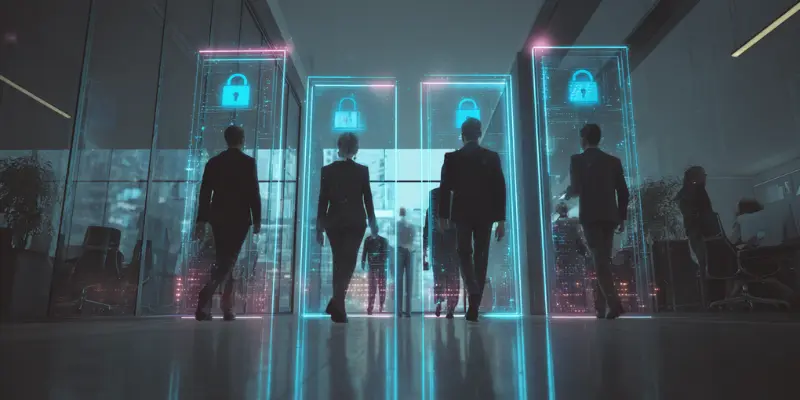IT/HR relations: services undergoing major upheaval
HR: A technological boom
In the context of technological development that companies are experiencing today, one department seems to face more difficulties than the others: the human resources department. Even if the constraints and opportunities linked to this increase seem to have been integrated, we are seeing a digital upheaval that is sometimes struggling to take hold.
Not long ago, in 2017, an ADP and IDC study revealed that human management was done manually in 22% of cases! 2020 brought a major shift and enabled extreme digitalization of all company services.

On the other hand, HR has a central role in the company and can be considered as a hub that interacts with all departments.
In 2017, 28% of HR teams stated that IT was not really involved in decisions regarding the selection of HCM solutions.
This is the big change that needs to be made. But on the IT side, how are things going?
IT: a change of role
Some time ago, we underwent a profound shift in the position of IT departments, which, until recently, had an executive role.
We consulted them for routine IT matters, but they were not often invited to choose new tools, and their requests for investments in IT systems and security were very often relegated to later.
Today, they have a role to play in the company and participate in major decisions; they must be proactive. Digital transformation passes through them, and their connection with all the company's services puts them in a balancing act: ensuring security and meeting the needs of everyone.
It is up to the IT department to manage its governance and instill new directions in order not to undergo changes. It must show its added value, especially since digital has recently taken on its full importance within companies!

Another major issue that has arisen recently is cybersecurity. While companies have turned away from this subject for years, they can no longer avoid it and even tremble before the ravages that cyberattacks produce. IT must position itself as an expert on the issue and impose its priorities in the broad outlines of the company's development.
The digital transformation within companies: HR and IT hand in hand (or almost!)
HR operated in a top-down manner, that is, they gave information, instructions, and these reached managers and employees without feedback from them. The information was seen as imposed.
To overcome this miscommunication, SaaS software solutions have emerged and, in addition, have met different needs. Relationships have improved, and the work of human resources has been modified.
Digital transformation concerns all company departments, not just HR or IT. HR and IT must support and manage this transformation. The HR department supports all employees in this change of behavior to avoid resistance, and the IT department works on changing tools and processes.
This is where a collaborative effort comes in to avoid friction between departments, or worse, between HR and IT. It is essential to automate HR processes and involve IT in the choice of HRIS.
We can no longer have two conflicting visions:
- HR: Employee management
- IT: Account Management
The Information Systems Department understands this well: we no longer manage accounts, but users who have multiple accounts.

The IT department to the rescue of human resources
IT services and the company have pushed HR departments to modernize rapidly in recent years. We have seen major developments in HRIS, software, and communication. Recently, teleworking has enabled a leap forward in employee management!
- HRIS systems no longer just manage payroll, leave, or schedules; they go further, enabling predictive recruitment.
- The cloud has also simplified the work of human resources and SaaS solutions bring simplicity and efficiency.
- We can also see a recent surge in enterprise social networks with Slack or Teams, which has been further reinforced with teleworking.
Employees 'consume' the company like any other service and want to live an exhilarating customer experience.
These major changes have enabled companies to adapt to the new expectations of employees who 'consume' the company like an everyday commodity. They, therefore, expect to experience a 'customer experience' and want HR to provide 'services' such as payroll, vacation, training, support, etc.
- Logically, an employee will appreciate that all of their data is only requested once. It is up to human resources and IT departments to coordinate to connect the HRIS with other tools. It is therefore the role of the IT department to ensure this connection and for HR to correctly fill in all the information at the outset.
- At the same time, IT must ensure the company's security by creating user accounts. The IS (Information Systems) department must provide technical support to HR.
- The IT department must act as a guide for the employee. If they wish to contact a department, it should be simple and there should not be one channel per department but one and the same channel for the entire company, leaving it to the IT department to manage this technically.
- HR departments accumulate a large amount of information but do not always have the skills to exploit it, and especially no tool to manage it (extract, group and present). It is up to IT to be proactive and help HR use this data.
HR and IT departments must therefore work hand in hand.
IT must help HR automate their actions and achieve a modern and pleasant image for candidates and employees, who are becoming increasingly volatile.
As for HR, they must enable IT departments to have a good relationship with other departments in the company through extensive communication.
The IT department is just as responsible as the HR department for the employer brand image.

A strategic intersection for both
So what's the 'sticking point' between these two major departments that may have gotten along like cats and dogs at times?
These two entities operate in radically different work ecosystems. While HR has an environment and processes that may have been very manual and are very human-oriented, IT departments are pioneers in task automation and manage accounts.
The two profiles, however, come into contact at key moments for the company: employee arrivals, departures, and evolutions. The quality of these points largely depends on the ability of HR and IT to synchronize their tasks. In the event of poor communication, malfunctions appear, and it is the employee who suffers the damage, tarnishing the company's image in the process.
It's quite a challenge to bring these two worlds together and ask them to find a compromise without speaking the same language!
How the HR and IT departments intersect in the administrative management of an employee.
Human Resources is the entry point with the employee. They manage the contract but also information relating to the manager, position, function, type of contract and duration, etc.
Information is transmitted to IT departments asynchronously; they will not receive all the information at the same time as HR, but only snippets of information that HR and potentially the manager will transmit to IT. At that point, they will be asked to create specific accounts such as internal messaging, email, and sometimes specific business software. It is then up to IT to create the accounts, considering everything necessary such as Active Directory, Office 365, and those requested. The creation is rather vague because IT has to guess what the employee will need. Furthermore, they do not know what rights to apply to all the accounts created.
In this regard, the exchange of information between the HR and IT departments is not fluid. Human resources does not necessarily have bad intentions by not including IT in the arrival or departure process, but they simply do not think about it. For them, IT is notified of the accounts to be created and that is enough, but we know that IT needs more information.
There may also be 'oversights' with the cancellation of an employee's arrival or a delay in their arrival that will not be specified to IT.
Upon departure, HR will not necessarily think to notify IT of an employee's departure, and at the same time, from their point of view, IT has no role to play at that moment.

The misunderstanding stems from HR feeling they are performing their role correctly, while IT feels left out.
Finally, a common language for human resources and IT?
Given this observation, what do we do?
There is no point in blaming one or the other who is not really at fault. It is therefore necessary to find a common language to facilitate dialogue and exchanges.
This is where IAM tools come in. What is it? IAM is the management of identities and access. These are solutions that automate onboarding and offboarding processes, as well as job changes within the company, in the management of user accounts and their access rights to software.
An IAM connects HR and IT in one place, so everyone can find the information they need. HR can facilitate arrivals and departures with workflows and checklists, and at the same time, IT receives the information in real-time and can automatically create all the necessary accounts for the employee with the correct permission adjustments.
IT can implement a system for monitoring rights as the employee progresses within the company. Upon their departure, HR, by closing their file, automatically sends a message that suspends all of the employee's accounts.
There are no more communication problems, no more wasted time, and even fewer security flaws thanks to an IAM solution.
The idea here is not to overload HR departments with additional tasks initially handled by IT, but rather to restore meaning to certain manual and laborious HR actions. Managing employees/users directly from a collaborative tool helps to improve communication between departments in the long term, thereby streamlining processes.





